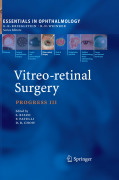
Since the introduction of vitrectomy in the 1970s, vitreoretinal surgery has rapidly developed. Initially, new instrumentations were created to facilitate intraocular maneuvers and to treat almost all the vitreoretinal pathologies. High speed vitrectome probs, forceps, scissors, endolaser probes, and new lightsources (xenon/photon light) permit us to perform safer surgeries. However, in the last few years the approach to vitreoretinal surgery has changed with the introduction of small gauge instruments and sutureless surgery. At present there is still confusion among vitreoretinal surgeons about the use of 25-, 23-or 20-gauge sutureless systems. Leading surgeons in the field were recruited to offer their insights into the sutureless techniques they perform. Indispensable for continuous education and advanced training All editors with international reputation and contributing authors with great expertise in their topic Well-structured text and design, quick and easy to read Bridges the gap betweenprimary literature and daily practice Every 2nd year each subject is covered with timely information about new developments in the specialised field INDICE: From the contents 25-Gauge Instrumentation – Engineering Challenges and Tradeoffs.- 25-gauge Vitreous Surgery: Getting Started.- Comparison of 25-gauge Trocar/Cannula Wound Healing and Remodeling with In Vivo Vitrector Flow Analysis.- 25-Gauge, Sutureless, Trans-Conjunctival Vitrectomy.- 23/25 gaugetrocars’ insertion technique/ 23/25 gauge "one-step" instrumentation.- 25-23 gauge vitrectomy for Rhegmatogenous Retinal Detachment.- 23-Gauge, Sutureless,Trans-Conjunctival Vitrectomy.- 25 gauge Macular Surgery.
- ISBN: 978-3-540-69461-8
- Editorial: Springer
- Encuadernacion: Cartoné
- Páginas: 210
- Fecha Publicación: 01/10/2008
- Nº Volúmenes: 1
- Idioma: Inglés
